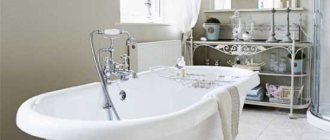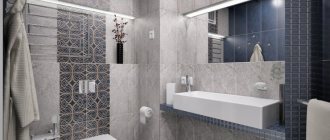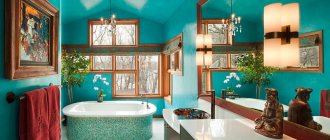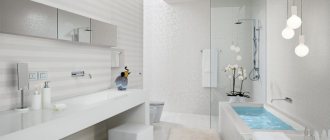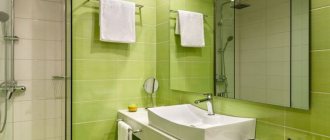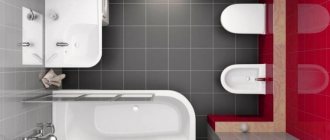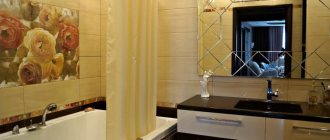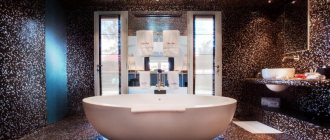finishing the bathroom with stone
Designing a bathroom is always fraught with difficulties, but not because it is difficult to choose the right design. The problem is somewhat different. Quite stringent requirements are imposed on the design of premises with such functionality. Finishing materials for them must certainly be waterproof, which is why the majority of owners are fixated on boring ceramic tiles. Why not look for a worthy alternative? How do you like the idea of using artificial stone, for example, as bathroom decor? Think it will be bulky and gloomy? Nothing like this! If you set your priorities correctly, your home can have at least a full-fledged island of relaxation, or even a real spa!
Features of the use of the material
What exactly can be decorated with decorative stone? In fact, almost everything - the bath itself, the countertop, the walls, the floor or the ceiling.
Of course, a bathroom made of natural stone is not a cheap pleasure, but the beauty of such materials can be used as a kind of addition to make the interior unique. Most often used for finishing:
- marble;
- granite;
- sandstone;
- quartzite;
- onyx.
Other types of stones are also widely used; they look very stylish and noble in the interior.
Artificial stone as the dominant material
In this case, artificial stone is used to decorate walls and floors. Here it would be more appropriate to give preference to traditional layout, in a straightforward, rational form. In this case, the texture of the selected material may differ, which will make it possible to visually expand the room, or focus on a certain place.
Artificial stone for wall cladding in the bathroom can be:
- Chipped, with jagged edges
- Sawed, with smooth polished edges
- Imitation of stones and cobblestones
- Imitation of decorative stones
- Natural look
Advantages of stone finishing
Bathrooms are characterized by high humidity, temperature changes and not always good ventilation. Often these factors contribute to the appearance of fungus and mold, so for finishing the room it is important to choose materials that are not afraid of moisture.
The stone has just the right properties. Experts especially note:- environmental friendliness of the material;
- high resistance to the negative effects of moisture and temperature changes;
- strength and long service life;
- the ability to restore the surface if necessary.
You should also highlight the disadvantages of using stone in bathroom decoration.
Advantages and disadvantages
Both natural and artificial materials have the following advantages:
- luxurious appearance;
- the ability to choose the color and texture to suit any interior;
- resistance to water, mechanical stress;
- complete absence of toxicity and allergenicity;
- mold or mildew does not develop;
- artificial material is easy to process and install;
- It is possible to make a custom-made bathtub or sink.
Using stone in the design of bathrooms also has its disadvantages:
- the cost of natural material is very high;
- Do not use abrasive products for cleaning - they will inevitably lead to scratches;
- coloring compounds (for example, hair dye) can change the color of the material;
- dark shades are not suitable for decorating small rooms.
Flaws
The main disadvantages of using the material are:
- high price;
- the weight of the products is too high;
- labor intensive processing and installation.
Most of all, consumers talk about the inflated price of stone products. The price is really high, but with the development of technology this issue has been partially resolved.
Thus, recently artificial types of stones have become very popular, which are cheaper, lighter and practically not inferior to the originals in their beauty and properties.
What is the difference between acrylic and quartz countertops?
These types of countertop materials differ in resin and type of aggregate, difficulty of processing, appearance and tactile sensations when touched.
The basis of an acrylic tabletop is acrylic resins, pigments and mineral fillers. It is more often used for surfaces with a sink. This material can imitate any natural stone. Acrylic allows you to create a custom shape with all the holes, protrusions and edges you need. If there are seams, they are easily sanded and polished and are almost invisible. The thickness of the acrylic tabletop slab is up to 12 mm; the frame itself is made of moisture-resistant plywood, so the thickness of the product itself can be any. The price per square meter of the product fluctuates around 6-10 thousand rubles.
The basis of a quartz countertop is quartz chips (its mass can be up to 95% of the product), the binding component is resin and pigment. The surface pattern imitates granite or marble. Quartz processing is more complicated; its properties and appearance resemble natural stone.
Quartz composite is one of the best artificial stone materials. Countertops made from it retain their original structure for many years, and in terms of strength they are second, perhaps, only to diamond.
A bathroom countertop made of quartz with a simple rectangular shape will cost less than its acrylic counterpart, but if additional work is required, its price will increase along with the complexity of the work. The thickness of the slab is usually 12,20 and 30 mm. For the bathroom, 20 mm is most often used.
Quartz composite is a non-toxic and completely inert material, making products made from it absolutely harmless to human health. Quartz composite does not emit harmful fumes into the environment even at high temperatures.
Photo: artificial quartz countertop
Recommendations
Even if you do not have a huge bathroom, but have a standard room, you can also successfully decorate your bathroom with a stone look. To do this, it is enough to carefully think through the design so that visually the room does not look even smaller.
It is not at all necessary to decorate the entire room with stone. In small rooms, experts recommend using some bright details - original ornaments or stone furniture (baths, countertops, etc.).
Let's talk in more detail about the features of a stone bathtub, because it is this item that is decisive in the bathroom.
How to work in a bathroom with stone-look tiles?
stone finishing is suitable for spacious baths
To get an original interior with an impressive atmosphere, it will not be amiss to get acquainted with a number of rules that specialists adhere to when working with such material.
- Don't skimp on light. There should be many sources of it, and it is advisable to place them at different levels. It doesn’t matter whether the bathroom tiles look like stone or are made of natural material, dark or light - such walls in any case will actively absorb light, significantly reducing the level of illumination in an already dark room.
- Experiment. Use combinations of materials. This is especially true if you plan to put a dark-colored artificial stone in the bathroom. It must be diluted with light inserts. These can be either plastered areas or areas decorated with wallpaper.
- Avoid using stonework as the main finish in narrow rooms. Even if there are a bunch of lamps, the interior will look gloomy. A small bathroom is styled like wood, and stone is added in the form of countertops and sinks, and then it becomes truly cozy and comfortable.
- Don't be afraid of rough materials. Sometimes the stone doesn't look very attractive. He seems rough and uncouth. First impressions are often deceiving. Framed by the smooth shapes of the furniture and delicate details filling the interior, the masonry will absolutely sparkle with different colors. Green plants and the sound of flowing water can also help soften the atmosphere.
Artificial stone for the bathroom is in perfect harmony not only with wood. It will be perfectly complemented by the shine of metal, glass and mirrors.
Baths made of natural stones
Not many bathtubs are made from natural rocks; their cost is simply not affordable for the average consumer. Therefore, this model range is not particularly diverse.
Also, the material is too heavy, which complicates the process of production and installation of plumbing products.
Types of bathtub models
Natural and artificial stone are used to make bathtubs. The cost varies depending on the complexity of the product and its size. Photos of stone bathrooms give an idea of current, popular models.
Natural. The cost of bathtubs made of natural stone is so high that it is not affordable for the general consumer. Stone processing is a complex and labor-intensive process; giving it an oval shape is not so easy, so the models do not differ in variety.
The most commonly used are marble and granite. The product is heavy, so installation is only permissible on concrete floors. High prices do not guarantee the absence of hidden defects that arise during processing.
Artificial. Visually indistinguishable from natural material - modern technologies make it possible to accurately convey the color, texture and characteristics of natural material. Imitation is characterized by lower cost, as well as lower weight of the product.
It is made from marble, granite, quartz chips in combination with polyester resins and plasticizers. Its qualities are similar to natural stone, but its prices are more affordable, which allows it to be in demand among a larger number of consumers.
Containers made of artificial materials
Modern technologies accurately reproduce the colors and textures of natural materials, so bathtubs made of artificial stone are practically no different in appearance from their counterparts.
Burgundy bathroom: how to create a stylish interior design and ideas for choosing the best combinations (100 photos and videos)Dark bathroom - stylish and elegant examples of design. Original projects, advantages, disadvantages and modern ideas (115 photos)
Bathroom interior - 120 photos of design ideas and rules for decorating a modern bathroom
In addition, they have similar performance properties, are cheaper and weigh much less, which allows them to be used more widely in creating interiors.
Stone-effect tiles in interiors of different styles
The stone, even if it is obtained artificially, will always be distinguished by the nobility of its design, which means that the material can be integrated into any stylistic decisions without any problems.
Loft
bathroom interior in loft style
This direction has prepared walls made of tiles imitating raw stone or brickwork and a sandstone floor for the bathroom. It is logical to use stone plumbing and furniture in the setting.
Rococo, Empire and the like
creating a bath in a small grotto
This is the realm of ostentatious luxury. Feel free to fill your decor with artificial stone, stone sinks and marble or fine granite countertops. The finish must certainly shine with a glossy shine. To give your interior design maximum expressiveness, you should consider installing a cabinet, bathtub or bidet made of natural stone.
Techno styles
This is a product of modernity, so a quartz agglomerate of angular and strict shapes in high-tech processing will appear in the bathroom setting. It can be complemented by the shine of metal and glass.
Modern
natural stone in a bathroom decorated in Art Nouveau style
Essentially it is a mix of natural materials and smooth lines. Light stone tiles are appropriate for bathroom decor. And no modules! The severity of the stone panels and the evenness of the lines will destroy the charm of the style. If you plan to have a stone countertop in the bathroom, ask to cut it in any shape and be sure to round the corners. The same applies to the shape of shells. Let them be oval, round, abstract.
Minimalism
minimalist bathroom design
The name speaks for itself. Only natural shades of stone-like tiles are used for interior decoration. You can make surfaces glossy. An excellent addition to the decor will be stone plumbing fixtures and mirrors.
Ethnic style
To decorate a bathroom, you will need an artificial stone of a natural shape, without signs of processing. In design circles, this material is known as “wild” stone. Its masonry should also be primitive. Living indoor plants will help soften the impression and make the atmosphere cozy. Such interior solutions are good for bathrooms with windows. Premises a la a spa can be designed in this vein. Maximum relaxation and tranquility are guaranteed here.
The ubiquitous classic
wood and stone are the hallmarks of the classic style
A bright representative of the trend can be considered a bathroom under wood and stone. Clarity of lines and strictness of forms are important here. If it is a sink or bathtub, then they should be oval, rectangular, square. Modern classics are not so pragmatic. There may be items of non-standard configuration in the room. Play of contrasts and bright colors are acceptable. The latter are added mainly in accessories.
Ethnics
stone counters as a highlight in the bathroom interior
Artificial stone tiles with a simple design and rounded shapes of the font and sink are suitable for any branch of the direction.
Decorating ideas
The photo above shows an interesting bathroom design with a savage finish. It can be either natural or artificial stone. Despite its disproportionate shape with a chopped surface, it can create an excellent surface if laid correctly. If natural material is used, then it makes sense to open it with varnish for greater resistance to moisture. The design includes a combination of several material options.
Here is another interesting example of fragmentary finishing. Here it performs not only a decorative, but also a practical function. As you can see, the wall in which there is a fireplace is lined with stone. Thanks to this solution, it was possible to achieve excellent heat transfer, as well as resistance of the finish to high temperatures. Taking a bath brings not only a relaxing effect, but also visual satisfaction, which comes in the process of contemplating a burning fire.
The photo above shows an example of a complete finish using natural material. Not everyone will like this solution, but it looks pretty neat. To prevent the room from seeming cluttered or unfinished, it is necessary to properly implement the lighting, which is what was done in this case. Small lamps are located around the perimeter and have directional light, which can be changed if necessary.
An example of finishing with a focus on the functional area. The finished surface goes well with the countertop. Thanks to the contrast of colors, they do not merge. Gypsum blocks that are varnished or natural material can be used as finishing.
This bathroom solution uses at least four types of blocks. One of them is granite, with which the wall is partially lined. Most of the wall and floor are covered with marble. The partition for the shower stall is made of wild wood, and the shower tray is lined with pebbles. In this case, there is no imbalance. Proper lighting and two mirrors visually expand the room.
The photo above is an example of how finishing with natural or artificial materials is also possible for small bathrooms. The main requirement is the choice of light colors. Snow-white sanitary ware goes well with sandstone. Minimalistic design with hanging elements does not clutter up the space. The effect is also added by a glass partition and a large mirror. The ceiling is also made in white, which complements the picture and harmonizes with the door.
Here is a rather unusual solution, which is based on an ordinary cobblestone. If you look closely, it is used not only in interior but also in exterior decoration, so the overall picture looks great. The floor is made of natural or self-leveling stone. Thanks to the use of light-colored seams, the surface does not look gloomy. When using cobblestones, you should be attentive to its quantity in the decoration. It is better to highlight one of the zones, but do not use it for continuous display on the walls, since the result will not be particularly pleasant.
A bright interior in the bathroom can be created through the use of marble. This project uses a complete finish with such material. The tabletop was also matched to complement the picture. Light marble goes well with chrome surfaces or stainless steel elements. If the floor is laid with the same stone, then it is necessary to provide heating, since the material has high thermal conductivity.
Here is an example of painstaking but wonderful work. Regular pebbles are used for finishing. Often there is no need to even purchase it. It is enough to go to a river or beach and pick it up there, if permitted by law. It is advisable to look for elements of the same size, but divergence will not be a particular problem, since individual elements can be sunk deeper into the glue. Pebbles are an ideal solution for the bathroom, as they are highly resistant to moisture. Such finishing can only cost the cost of glue and personal time.
Although in this design the stone is deliberately laid out in this way, it serves as an example of the fact that in some cases there is no point in thinking about how the bathroom will be finished. It is enough to use what you already have. The main thing is to approach the processing of seams correctly and choose the appropriate plumbing fixtures. You can get more ideas from the video below.

